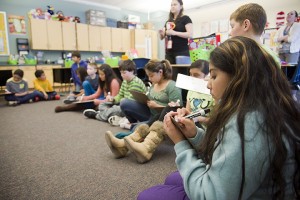
By Ericka Mellon
Associated Press
Working on a math assignment, the 6-year-old girl placed Popsicle stick after Popsicle stick in a horizontal line on the table. “Uno, dos, tres,” she counted, all the way to 10.
Next, the kindergartner, Isabelle Kao, plotted 15 dominoes.
“Cual es más largo?” (which is longer?) her teacher, Graciela Martinez, asked. She gave the girl a hint, extending her arms wide.
Isabelle pointed correctly to the longer line — the sticks.
Martinez’s class at Mark Twain Elementary in southwest Houston is one of a growing number of two-way dual-language classrooms, where native English speakers like Isabelle and native Spanish speakers learn together.
Like school systems across the nation, several local districts — including Houston, Alief, Clear Creek, Pasadena and Spring Branch — have expanded dual-language programs, as more parents want their children to grow up bilingual and studies generally show positive academic results.
Still, districts can face a series of challenges in starting such programs, including persuading anxious parents, recruiting enough bilingual teachers and ensuring effective instruction at a time when young children are ripe for learning languages but at risk of sliding behind their peers.
“Dual language is a difficult thing to do well,” said Julie Sugarman, senior research associate at the Center for Applied Linguistics. “But this really works for helping English learners develop English.” At the same time, she said, English speakers gain fluency in another language.
Speaking in Spanish, teacher Graciela Martinez works with kindergartner Alejandro Gerlein on a lesson about weight measurement in the dual-language program at Mark Twain Elementary.
Across Texas, more than 66,800 public school students are enrolled in two-way dual-language programs, about twice as many as in 2009-2010, according to Texas Education Agency data.
The percentage of students in the programs remains small but is rising. The Houston Independent School District, the state’s largest district, plans to double its number of elementary schools with dual-language programs to 28 next year.
At most of the schools in HISD and across Texas, however, the majority of Spanish-speaking students take traditional bilingual classes, where instruction is heavy in Spanish in the early grade levels and phased out as they age.
In dual-language programs, instruction in Spanish (or whatever the second language is) continues. The models vary. Kindergarten students typically receive instruction in Spanish either half the time or 80 percent to 90 percent of the time. By fifth grade, the instruction usually is split evenly between the two languages.



